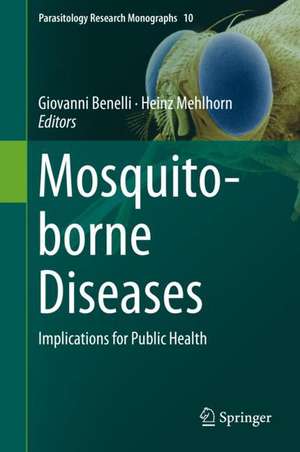Mosquito-borne Diseases: Implications for Public Health: Parasitology Research Monographs, cartea 10
Editat de Giovanni Benelli, Heinz Mehlhornen Limba Engleză Hardback – 15 noi 2018
This book gathers contributions by 39 international specialists on well-known but neglected mosquito-borne diseases. The authors highlight pathogens that are increasingly being spread worldwide by various mosquito species, a situation worsened further by migration and tourism.
The book addresses significant agents of diseases like AIDS, dengue, Zika virus, malaria and even cancer, and the risk of transmission via mosquito-related vectors. In addition, it examines important means of preventing the outbreak of related diseases by using insecticides and/or repellents.
A particular focus is on the unique and sophisticated mouthparts of bloodsucking species, which allow them to feed on blood in an undisturbed manner, and by means of which agents of disease can enter potential human and animal hosts.
In brief, the book provides a broad range of information for a wide readership, including graduates, teachers andresearchers in the fields of parasitology, virology, tropical medicine and microbiology, as well as practitioners and healthcare officials.
Din seria Parasitology Research Monographs
- 15%
 Preț: 644.95 lei
Preț: 644.95 lei - 18%
 Preț: 1113.39 lei
Preț: 1113.39 lei - 18%
 Preț: 1221.38 lei
Preț: 1221.38 lei - 18%
 Preț: 940.87 lei
Preț: 940.87 lei - 18%
 Preț: 952.57 lei
Preț: 952.57 lei - 18%
 Preț: 727.00 lei
Preț: 727.00 lei - 18%
 Preț: 1104.43 lei
Preț: 1104.43 lei - 18%
 Preț: 781.45 lei
Preț: 781.45 lei - 18%
 Preț: 1105.68 lei
Preț: 1105.68 lei - 18%
 Preț: 944.99 lei
Preț: 944.99 lei - 18%
 Preț: 1114.02 lei
Preț: 1114.02 lei - 18%
 Preț: 1112.60 lei
Preț: 1112.60 lei - 18%
 Preț: 1219.46 lei
Preț: 1219.46 lei - 18%
 Preț: 1226.73 lei
Preț: 1226.73 lei - 18%
 Preț: 946.55 lei
Preț: 946.55 lei - 18%
 Preț: 945.92 lei
Preț: 945.92 lei - 18%
 Preț: 950.21 lei
Preț: 950.21 lei - 20%
 Preț: 563.85 lei
Preț: 563.85 lei
Preț: 904.14 lei
Preț vechi: 1189.66 lei
-24% Nou
Puncte Express: 1356
Preț estimativ în valută:
173.03€ • 187.88$ • 145.34£
173.03€ • 187.88$ • 145.34£
Carte tipărită la comandă
Livrare economică 18-24 aprilie
Preluare comenzi: 021 569.72.76
Specificații
ISBN-13: 9783319940748
ISBN-10: 3319940740
Pagini: 364
Ilustrații: VI, 354 p. 125 illus., 68 illus. in color.
Dimensiuni: 155 x 235 mm
Ediția:1st ed. 2018
Editura: Springer International Publishing
Colecția Springer
Seria Parasitology Research Monographs
Locul publicării:Cham, Switzerland
ISBN-10: 3319940740
Pagini: 364
Ilustrații: VI, 354 p. 125 illus., 68 illus. in color.
Dimensiuni: 155 x 235 mm
Ediția:1st ed. 2018
Editura: Springer International Publishing
Colecția Springer
Seria Parasitology Research Monographs
Locul publicării:Cham, Switzerland
Cuprins
Mosquito transmission of HIV – rare or not possible?.- How to protect people from malaria when the diffusion of insecticide resistant Anopheles mosquitoes will have abolished efficacy of the major vector control tools?.- Elettaria cardamomum (L.) fabricated ferric nanoparticles exhibits antivectorial and antiviral activity in Dengue virus type 2 infection.- Vector potential of mosquito species (Diptera: Culicida).- Mosquitoes endangering health in China.- Essential oils from aromatic and medicinal plants as effective weapons against mosquito vectors of public health importance’?.- Introduction - Why are mosquitoes dangerous: adaptations in life cycles and behaviour.- Morphology of mouthparts of mosquitoes and related species adapted to blood sucking.- Protection from mosquito bites in army field activities.- Zika virus epidemics – a sudden outbreak?.- Natural disasters and transmission of parasites; what is the role of veterinarians to play? - from theory to praxis.- Mosquitoes as arbovirus vectors: from species identification to vector competence.- Threats by mosquito-borne pathogens in Europe.- Mosquitocidal and antiplasmodial potential of Syzygium cumini fabricated silver nanoparticles and its toxicity against predatory fish.- Mosquito-borne diseases: Prevention is the cure for Dengue, chikungunya and zika viruses.- Long-lasting insecticide-treated textiles preventing from mosquito bites and mosquito-borne diseases.- Molecular aspects of species of the genus Aedes with epidemiological importance
Textul de pe ultima copertă
This book gathers contributions by 39 international specialists on well-known but neglected mosquito-borne diseases. The authors highlight pathogens that are increasingly being spread worldwide by various mosquito species, a situation worsened further by migration and tourism.
The book addresses significant agents of diseases like AIDS, dengue, Zika virus, malaria and even cancer, and the risk of transmission via mosquito-related vectors. In addition, it examines important means of preventing the outbreak of related diseases by using insecticides and/or repellents.
A particular focus is on the unique and sophisticated mouthparts of bloodsucking species, which allow them to feed on blood in an undisturbed manner, and by means of which agents of disease can enter potential human and animal hosts.
In brief, the book provides a broad range of information for a wide readership, including graduates, teachers andresearchers in the fields of parasitology, virology, tropical medicine and microbiology, as well as practitioners and healthcare officials.
Caracteristici
Enriches understanding of pathogen transmission of mosquito-borne diseases Covers a broad spectrum of agents with public health importance Discusses protection methods against vectors and pathogens Explains behavioural and morphologic specialisation of blood sucking species
